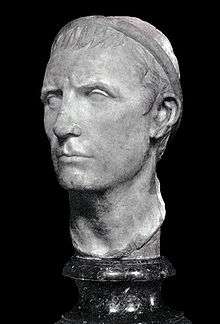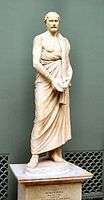Hellenistic portraiture
Hellenistic portraiture was one of the most innovative features of Hellenistic art. Spurred on by an increased interest in realism, Hellenistic sculptors sought to produce true-to-life portraits defined by the individualism of their subjects[1]. Emergent at this time is a focus on a range of states of mind such as inebriation and concentration, as well as physical characteristics like senescence and anatomical abnormality - in great contrast with the idealised forms of the Classical period[2][1]

Portrait of Antiochus III
Lysippos
Development of physiognomy
Official portraiture
Gallery
 Portrait of Demosthenes
Portrait of Demosthenes- Pseudo-Seneca at Naples
Notes
- Griffiths Pedley, John (1993). Greek Art & Archaeology. Laurence King. p. 350.
- Barringer, Judith M. (2014). The Art and Archaeology of Ancient Greece. Cambridge University Press. p. 342.
Bibliography
- (in Italian) Ranuccio Bianchi Bandinelli, Il problema del ritratto, in L'arte classica, Editori Riuniti, Rome 1984.
- (in Italian) Pierluigi De Vecchi and Elda Cerchiari, I tempi dell'arte, volume 1, Bompiani, Milano 1999.
gollark: All necessary computation and storage is instead being offloaded to users.
gollark: Our infinitely powerful computer is currently nonexistent for legal reasons.
gollark: If you use an infinitely powerful computer it'll be possible to autogenerate a program for this in no time!
gollark: Solution: program your own library for extended regexes.
gollark: Rust's main regex library, alas, limits regex features a lot to keep good performance.
This article is issued from Wikipedia. The text is licensed under Creative Commons - Attribution - Sharealike. Additional terms may apply for the media files.